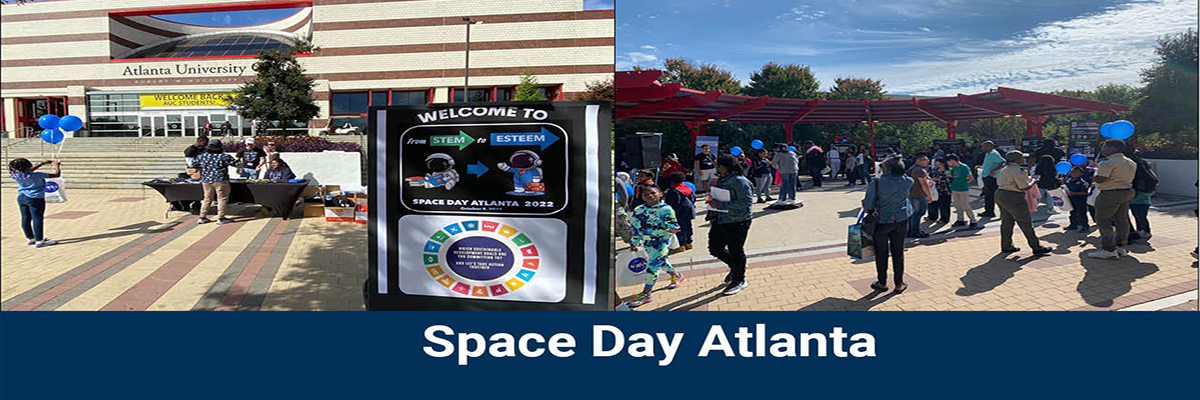Georgia Tech students give back to the community

During World Space Week, local K-12 students interested in science, technology, engineering, and mathematics (STEM) came in droves to experience Space Day Atlanta at the AUC, held this year at partner Atlanta University Center’s Woodruff Library. The free annual event provides STEM access to children of all backgrounds in a fun and interactive atmosphere.
Organizers John Hines, Hines Family Foundation; Justin Ballenger Morehouse College and Atlanta University Center Data Science Initiative; Bettina Gardner and Eboni Dotson, Atlanta University Center Data Science Initiative; Lori Skillings, Georgia Space Grant Consortium (GSGC); and Simeon Salia, Madhukarthik “Karthik” Mohanalingam, Georgia Tech School of Aerospace Engineering (AE) had the event running like a well-oiled machine.
More than 65 Georgia Tech students volunteered their time and talent during the event to reach the next generation.
 |
| Stephen Ruffin |
“The School of AE and GSGC were proud to be on the team that made Space Day Atlanta a success. This is consistent with our commitment to conduct K-12 outreach to support the need for diverse STEM talent. The fact that over 65 Georgia Tech students served as volunteers means the GT motto of ‘progress and service’ is flourishing,” said Stephen Ruffin, associate dean for academic affairs, Georgia Tech Professional Education and director of the Georgia Space Grant Consortium.
This year’s event featured a presentation from retired NASA astronaut Yvonne Cagle, Ph.D. who spoke to attendees about the upcoming Artemis missions and their ties to the Apollo missions. She also explained what it takes to be an astronaut and gave the attendees an encouraging message.
Georgia Tech students served at hands-on booths bringing their science and engineering knowledge and most importantly an eagerness to teach budding young minds. They also worked the registration tables handing out raffle tickets, balloons, and NASA goodie bags, as well as setup and breakdown. Many of the booths were interactive and demonstrated everything from making spacecraft orbiters to understanding how black holes and gravity work in space. Participants asked questions and interacted with volunteers.
The balloon rocket booth was a hit with the K-12 crowd because they could stomp a bag to send small foam rockets into the air. Some rockets traveled as high as ten feet. Manas Mantha, Karthik Mohanalingam, and Zain Pastula helped attendees blast their rockets off into the air with a powerful punch.
Participants used chopsticks, metallic ribbon, and aluminum foil to make their own comets with the help of Daamini Vaisalaaksi, while Harry Shrager explained what a comet was and the difference between a comet and an asteroid.
For participants curious about the moon, the crater booth offered the touch and feel of the moon's surface using flour and water. Bella Giordano, Jalen Cauley, and Deshawn Johnson encouraged participants to put their hands in the bowls of flour while they explained how the moon’s surface differed from the earth’s surface.
Cody Deacons, Tyler White, and Griffen Jourdan from the Ramblin’ Rocket Club’s Experimental Rocketry (GTXR) team offered attendees a look at real rockets. They shared how the club makes rockets and about their recent trip to the Mojave Desert in California where they launched them into the sky.
 |
| Moon Map |
Attendees couldn’t miss the gigantic textured moon map on the ground in front of the library, by the Aldrin Foundation. Ethan Sirak and Miguel Daly assisted attendees to operate a small land rover (designed and built during AE’s summer STEP high school camp) on the map’s surface. Parent Alicia Johnson explained why she brought her daughters. “For them to learn about space and get insight into different aspects of science and NASA is important. I also wanted them to have exposure to exploring space.”
Tied to the space and sustainability theme, Mercer University, College of Education and STEM Education Innovation Lab, and the Hines Family Foundation volunteers showcased a hydroponics water system to show how astronauts grow fresh fruits and vegetables in space. Attendees even walked away with a kit to grow their own vegetables.
Attendees also met with NASA AMES engineers and learned about their collaborative research (along with students from Georgia Tech, the University of Maryland, and San Jose State) in developing a networked communication system for space to share data using CubeSats.
Event sponsors included: GSGC (a NASA Office of STEM Engagement program), Hines Family Foundation, Atlanta University Center Data Science Initiative, Morehouse College, Mercer University, Subsume Studios, Ignited Thinkers, and Simulatorr.
GA Tech Volunteers: Ruby Al Fawares, Mohammed Al-Mahrouqi, Siddhi Ameser, Shalomi Arulpragasam, Jesudunsin Awodele, Spencer Baird, Naveen Balaji, Deri Barnes, Heather Beers, Chahat Bhatia, Benjamin Bi, Christina Buffo, Jalen Cauley, Anika Chawla, Miguel Daly, Nathan Daniel, Bryant Dean, Paula Delfin, Sparsh Desai, Tyler Farr, Savri Gandhi, Rebekah Geil, Joey Gemini, Tatiana Gibson, Kenneth Grant, Rebecca Guth-Metzler, Aaron Hammond, Mark Hartigan, Luis Hatashita, Ari Jain, Deshawn Johnson, Emma Johnson, Emma Joly, Griffin Jourda, Ananya Kapoor, Andy Kapperman, Manas Mantha, Madhukarthik Mohanalingam, Imani Mooketsane, Aravind Karthik Muralidharan, Navya Narayanam, Ngefor Ndifor, Gabriel Nixon, Zain Pastula, Mira Patel, Rishikesh Prabhuram, Ruhani Prasad, Papa Ebo Quainoo, José Ramírez Colón, Johnathan Rankine, Tessa Rogers, Simeon Salia, Harry Shrager, Aarushi Shah, Scott Sims, Anisha Singh, Ethan Sirak, Jaznae' Smith, Cameron Smith, Kenneth W Smith Jr, Micaiah Smith-Pierce, Naveen Raj Srinivasan, Sonia Thakur, Advaith Krishna Teja Thellajala, Maya Tyson, Daamini Visaalaakshi, Chris Walter, Ellen Wang, Banglue Wei.
Monique Waddell